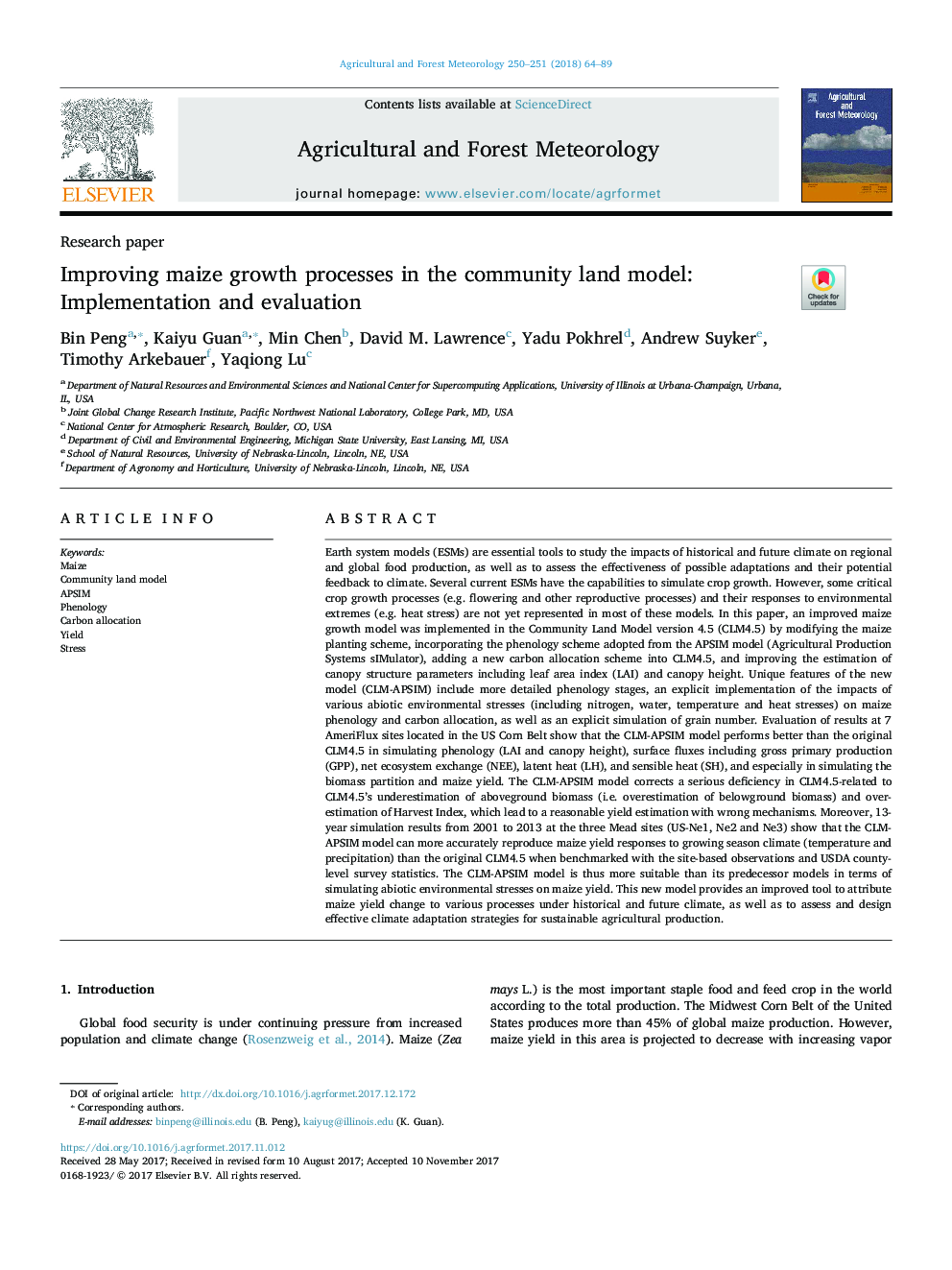| کد مقاله | کد نشریه | سال انتشار | مقاله انگلیسی | نسخه تمام متن |
|---|---|---|---|---|
| 6536791 | 1420851 | 2018 | 26 صفحه PDF | دانلود رایگان |
عنوان انگلیسی مقاله ISI
Improving maize growth processes in the community land model: Implementation and evaluation
ترجمه فارسی عنوان
بهبود فرآیند رشد ذرت در مدل زمین محلی: اجرای و ارزیابی
دانلود مقاله + سفارش ترجمه
دانلود مقاله ISI انگلیسی
رایگان برای ایرانیان
کلمات کلیدی
موضوعات مرتبط
مهندسی و علوم پایه
علوم زمین و سیارات
علم هواشناسی
چکیده انگلیسی
Earth system models (ESMs) are essential tools to study the impacts of historical and future climate on regional and global food production, as well as to assess the effectiveness of possible adaptations and their potential feedback to climate. Several current ESMs have the capabilities to simulate crop growth. However, some critical crop growth processes (e.g. flowering and other reproductive processes) and their responses to environmental extremes (e.g. heat stress) are not yet represented in most of these models. In this paper, an improved maize growth model was implemented in the Community Land Model version 4.5 (CLM4.5) by modifying the maize planting scheme, incorporating the phenology scheme adopted from the APSIM model (Agricultural Production Systems sIMulator), adding a new carbon allocation scheme into CLM4.5, and improving the estimation of canopy structure parameters including leaf area index (LAI) and canopy height. Unique features of the new model (CLM-APSIM) include more detailed phenology stages, an explicit implementation of the impacts of various abiotic environmental stresses (including nitrogen, water, temperature and heat stresses) on maize phenology and carbon allocation, as well as an explicit simulation of grain number. Evaluation of results at 7 AmeriFlux sites located in the US Corn Belt show that the CLM-APSIM model performs better than the original CLM4.5 in simulating phenology (LAI and canopy height), surface fluxes including gross primary production (GPP), net ecosystem exchange (NEE), latent heat (LH), and sensible heat (SH), and especially in simulating the biomass partition and maize yield. The CLM-APSIM model corrects a serious deficiency in CLM4.5-related to CLM4.5's underestimation of aboveground biomass (i.e. overestimation of belowground biomass) and overestimation of Harvest Index, which lead to a reasonable yield estimation with wrong mechanisms. Moreover, 13-year simulation results from 2001 to 2013 at the three Mead sites (US-Ne1, Ne2 and Ne3) show that the CLM-APSIM model can more accurately reproduce maize yield responses to growing season climate (temperature and precipitation) than the original CLM4.5 when benchmarked with the site-based observations and USDA county-level survey statistics. The CLM-APSIM model is thus more suitable than its predecessor models in terms of simulating abiotic environmental stresses on maize yield. This new model provides an improved tool to attribute maize yield change to various processes under historical and future climate, as well as to assess and design effective climate adaptation strategies for sustainable agricultural production.
ناشر
Database: Elsevier - ScienceDirect (ساینس دایرکت)
Journal: Agricultural and Forest Meteorology - Volumes 250â251, 15 March 2018, Pages 64-89
Journal: Agricultural and Forest Meteorology - Volumes 250â251, 15 March 2018, Pages 64-89
نویسندگان
Bin Peng, Kaiyu Guan, Min Chen, David M. Lawrence, Yadu Pokhrel, Andrew Suyker, Timothy Arkebauer, Yaqiong Lu,
